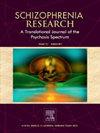Subjective emotional experiences in clinical high-risk youth: Insights from a dyadic interaction paradigm
IF 3.6
2区 医学
Q1 PSYCHIATRY
引用次数: 0
Abstract
Alterations in emotional functioning are a characteristic symptom of psychotic disorders. The clinical high-risk (CHR) period provides an important time for investigating early mechanisms, and their relation to psychosis vulnerability. However, our understanding of subjective emotional experiences in this critical population, particularly contextualized within social interactions, is limited. To address this gap, the present study aimed to evaluate subjective emotional experiences in CHR youth (12−30) using an experimental dyadic interaction paradigm. The sample included 148 individuals, 36 CHR-Partner dyads and 41 Control-Partner dyads, who engaged in three 10-min dyadic interactions (i.e., neutral, conflict, and pleasant). Following each conversation, participants reported the intensity of their positive and negative emotional experiences. Participants also completed a series of structured clinical interviews. CHR youth reported greater negative emotional experiences following pleasant conversations than control youth (U(74) = 533.5, p = 0.035). In CHR youth, greater negative emotional experiences following neutral conversations were associated with greater positive (rs = 0.37,pcorr = 0.046) and negative (rs = 0.44, pcorr = 0.038) psychosis-risk symptoms. Significant differences between CHR and control dyads were found for youth-partner discrepancies in positive emotional experiences following neutral (U(72) = 883, pcorr = 0.014) and conflict (t(72) = 3.28, p < 0.005) conversations as well as negative emotional experiences following neutral (U(72) = 914, p < 0.005) and pleasant (U(71) = 855.5, p = 0.043) conversations. Greater discrepancies in negative emotional experiences between CHR youth and partners following the neutral conversation were associated with greater negative symptoms (rs = −0.42, p < 0.05). These results provide understanding into mechanisms driving socioemotional functioning in CHR individuals and can inform interventions that target close relationships to improve outcomes.
临床高危青年的主观情绪体验:来自二元互动范式的见解
情绪功能的改变是精神障碍的典型症状。临床高危期为探讨早期发病机制及其与精神病易感性的关系提供了重要的时间。然而,我们对这一关键人群的主观情感体验的理解是有限的,特别是在社会互动的背景下。为了解决这一差距,本研究旨在使用实验二元互动范式评估CHR青年(12 - 30)的主观情绪体验。样本包括148名个体,36名CHR-Partner二人组和41名Control-Partner二人组,他们参与了三种10分钟的二元互动(即中立、冲突和愉快)。在每次谈话之后,参与者报告了他们积极和消极情绪体验的强度。参与者还完成了一系列结构化的临床访谈。与对照组相比,CHR青年在愉快交谈后报告了更多的负面情绪体验(U(74) = 533.5, p = 0.035)。在CHR青年中,中性对话后更大的消极情绪经历与更大的积极(rs = 0.37,pcorr = 0.046)和消极(rs = 0.44, pcorr = 0.038)精神病危险症状相关。青少年伴侣在中性(U(72) = 883, pcorr = 0.014)和冲突(t(72) = 3.28, p <;0.005)对话以及中性后的负面情绪体验(U(72) = 914, p <;0.005)和愉快的谈话(U(71) = 855.5, p = 0.043)。在中性对话后,CHR青年和伴侣之间的负性情绪体验差异越大,负性症状越大(rs = - 0.42, p <;0.05)。这些结果为了解CHR个体的社会情感功能驱动机制提供了依据,并为针对亲密关系的干预措施提供了依据,以改善结果。
本文章由计算机程序翻译,如有差异,请以英文原文为准。
求助全文
约1分钟内获得全文
求助全文
来源期刊

Schizophrenia Research
医学-精神病学
CiteScore
7.50
自引率
8.90%
发文量
429
审稿时长
10.2 weeks
期刊介绍:
As official journal of the Schizophrenia International Research Society (SIRS) Schizophrenia Research is THE journal of choice for international researchers and clinicians to share their work with the global schizophrenia research community. More than 6000 institutes have online or print (or both) access to this journal - the largest specialist journal in the field, with the largest readership!
Schizophrenia Research''s time to first decision is as fast as 6 weeks and its publishing speed is as fast as 4 weeks until online publication (corrected proof/Article in Press) after acceptance and 14 weeks from acceptance until publication in a printed issue.
The journal publishes novel papers that really contribute to understanding the biology and treatment of schizophrenic disorders; Schizophrenia Research brings together biological, clinical and psychological research in order to stimulate the synthesis of findings from all disciplines involved in improving patient outcomes in schizophrenia.
 求助内容:
求助内容: 应助结果提醒方式:
应助结果提醒方式:


